 Using PC PipeDream on your Desktop
Using PC PipeDream on your Desktop
This space is being written at the moment, so information might seem incomplete. Come back later, or watch this space so you can receive update notifications when new stuff is being written.
Introduction
This space provides details about how you can use PC PipeDream as a companion to your Cambridge Z88 portable computer, on any desktop that can support MS DOS virtualisation. It does not go into detail on all the commands, or to replace the manual (which is still available). The aim is
- to give a bit of history about the product
- a brief description
- to show the similarities and differences between the PC and Z88's versions
- show how the files can be converted to different formats so that they can be used with modern programs
- check whether files can be transferred from and to the Z88 with the different virtual machines.
History
PipeDream was an evolutionary product. It is a word processor, spreadsheet and database rolled into a single program. Its origins lie in View, Acorn's word processor for the BBC micro and Master series. Written by Mark Colton, PipeDream as a concept first appeared as View Professional for the BBC micro for the British educational market. Subsequently it was adopted and bundled in with the Cambridge Computer Z88. In 1988 PipeDream, two versions were released with additional spreadsheet functionality. One for the Acorn Archimedes, and the other for the IBM PC and compatibles (using 16-bit MS DOS),. There was an optional spellchecker, but this now is included in the current version. It is the PC version that we are using in this article.
Looking back at my (Vic Gerhardi, Rakewell.com, ed.) records, the first contact I had with Colton Software was on the recommendation of Tim Routsis on the 28th January 1988. Subsequently on the 18th May, I ordered
| PC Pipedream | ..................... | £99.00 |
| PipeDream Manual | ..................... | £14.95 |
| PC Link II EPROM Card | ..................... | £15.00 |
The Z88 was already in the marketplace and there was a growing demand for PipeDream to be available on the PC. There was a saying then that 'Nobody got the sack for ordering a IBM PC,' so there was a bit of a race on to see which of the many software products would become a 'market leader.'
PC PipeDream is still a useful tool to work on your transferred PipeDream documents, post-processed on your modern power-desktop such as Windows XP and newer, MAC OS X and Linux systems. How is that possible, when PC PipeDream is a DOS application? The answer is through virtualisation. The screenshot below comes from a running PC PipeDream on a 64-bit Windows 8 Desktop using Hyper-V.
For further information of other software packages written by Colton Software after PC PipeDream, with free downloads, and continued support go to this web site.
Description
On loading, PipeDream presents a spreadsheet layout of just one row. As rows are added the rows and columns create a matrix of hidden cells. It can be used just for that purpose, as a spreadsheet. If a word processor, is required just start typing. The spreadsheet layout is just as amenable to word processing as to spreadsheet use. If an embedded spreadsheet is entered in the text, use the spreadsheet functions in the cells. Referring to the text and values elsewhere in a spreadsheet is just as straightforward. Text and numeric data may easily be treated as records within a database for retrieval as required.
Think of PipeDream as a sheet on which text, spreadsheets and databases may all be set up. A menu bar at the top of the screen gives access to seven pull-down menus. These may be accessed by pressing the
WORKING WITH TEXT
The first step in using PipeDream is learning how to move about the sheet, up, down left and right. Text may be entered starting in any column and will extend to the right till the right-hand margin for that column is reached. Multiple column format is easily achieved with separate right-hand margins for each column. All the expected word processing operations are catered for and work well. Blocks of text are highlighted by moving to the start and the end, and may then be moved, copied or deleted. Text can also be surrounded by special markers to indicate the use of bold, italics etc on printing. Tab stops cannot be set and used in the accepted way, as the
WORKING WITH NUMBERS
Numbers and expressions, including a wide range of special functions, may be entered into any slot if first designated as an expression slot (this can also be set up as a default). Expressions may consist of numbers, dates, functions, conditions, strings, ranges, lists and slot references (a range is a consecutive set of cells, a list of individual cells). These may be entered individually or combined using various mathematical and conditional operators. Fourteen mathematical functions are provided, plus 11 financial functions (e.g. loan repayment, cash flow etc.), 13 general functions and 9 database functions.References can be entered into expressions by moving the cursor to the appropriate cell, but this is not as automatic and requires an extra key depression (
DATABASE FUNCTIONS
Any data may be inserted in rows and columns to form a database. Values may be sorted or matched, and some nine special functions will perform tasks such as totaling and locating maximum and minimum values. The facilities are a long way short of any full blown database system, but useful none the less in the context.
OTHER FEATURES
The menu system works well and provides a wealth of functions. Page layouts are readily created with headers and footers as required with good control over printing including various highlights such as italic and underlined text. Printer drivers are supplied for the Juki 6100 and Epson FX80, but other drivers are readily created by editing the files supplied using PipeDream itself.There are also facilities to enable files to be transferred between PipeDream and Lotus 1-2-3, and of course there is complete compatibility between the Archimedes version of PipeDream and those running on the PC or Z88.
CONCLUSIONS
PipeDream has much to commend it, not least an excellent manual. There may be word processors or spreadsheets which offer more in their respective applications, but for its unique combination of talents PipeDream has much going for it.
Screen Size
There are two sizes of the screen, the 'Deep Screen' mode size is shown above, whist the normal display is shown below.
Menu, Mouse and Cursor Operations
There is no mouse support. All operations are given by using
- keyboard commands or
- by using the Menu commands which are shown along the top horizontal banner. Using
Z88 Users will notice that the command letters match the ones they are used to (with a few exceptions). The
Selection of the commands, once in the menus, can also be selected using the , , and cursor keys.
Using Virtual Machines
There are a number of gotchas, when using two computers.
- File names - Remember which computer the files are in. In the following example, the files are on the Virtual Machine, not the Server. They both have C: drives and it is easy to get them muddled up when working with the same keyboard, mouse and display.
PipeDream is NOT Millennium Compliant
Z88 PipeDream is millennium compliant. Tests done on PC PipeDream to see if it is compliant reveals that it fails. The "DATE" command picks up the right date from our computer clock (after setting it to a 2000 date) and the calculations work as shown on the above screen shot. Year 2000 is now known as year 100. The last date that PC PipeDream can calculate is 19.1.102. You can convert your old PipeDream files to Lotus 1-2-3 format and carry on working on the file with a different spreadsheet package. Subtracting 20 years allows its continued use.
| |
| [Screen shot of PipeDream test in DOS window under Windows 95] |
DOS and Windows File names
A DOS file name is in the format of eight characters, a period (.) then a further 3 characters. This is described as 8.3 file name. A windows file name can, and usually is, longer. The effect of this is that if a long Windows file name is viewed in a DOS program, the file name does not appear correctly. See what happens if PipeDream is used in the C:\Program Files\DOS\PIPED directory when using the following command.
Notice that the DOS directory is shown as C:\PROGRA~1\DOS\PIPED instead of the correct name in Windows, C:\Program Files\DOS\PIPED.
This is why it is suggested that all DOS programs are installed in C:\DOS directory, keeping all directory names short and near the root.
Saving files
When saving files,
The only line that we are interested in is the last one. There are five options.
| Format | To be used | Type of File | Name | Comments |
|---|---|---|---|---|
| Pd | In PipeDream | Multi function | PipeDream | |
| Lotus | In Spreadsheets | Contains formulaes | Lotus 1-2-3 | Microsoft do not convert this file format in Excel 2013. Lotus /IBM SmartSuite Approach 9 has issues in Windows 8. |
| Comma | In Databases | One line per record, commas separating fields | Comma delimited | |
| Tab | In Word processing | Plain Text | ||
| Auto | When Loading | Will load correct format if saved by PipeDream |
Direct comms between PC and Z88 using Pipedream
*** I HAVE GOT TO TEST THIS ****
The PipeDream User guide states that you prefix the filename with Z: or Z88:
"you can speciy which port the Z88 is connected to:
Z:1: means serial port 1.
Z:2: means serial port 2."
It doesn't specifically give the example for COM.3, but give it a try. It should work with the Eazylink ROM using the PClink II codes.
I have just tried this using :COM.7 with the USB Cable and it doesn't work. So I suspect only COM.1 and COM.2 hardware ports are supported.
Also Eazylink client v 5.2 - 06 doesn't work immediately with PC Link II codes at present, just keep trying to connect, it gets there in the end. I have raised this as an issue.
STOP PRESS
=========
I have got this working with PipeDream by doing the following.
I am running Windows xp with COM.1 and COM.2 being hardware ports and COM.7 being the USB port.
In the Device Manager, I selected the Hardware COM.1 right clicked for Properties, In properties, I selected Port Settings. In Port settings I selected Advanced. In Adavanced Settings I changed the COM Port Number to an unused number - in my case COM.11, then selected OK.
I repeated this proceedure with COM.7, my USB com port, changing this to use COM.1.
In PC Pipedream, when doing 'File Load' (Alt FL), Change the File to Load to :Z88*.* If it comes back with bad z88 link, try again several times. This is also true if using the PC Link II program.
Footnotes
Protechnic - Tim Routsis
Mike Williams wrote about PC PipeDream in the July/August 1988 issue of RISC User Page 12-13
Product PipeDream - Supplier Colton Software, Broadway House, 149-151 St Neots Road, Cambridge CB3 7W. Tel. (0954) 211472 Price £113.85 Inc. VAT.
PC PipeDream Reviews
Pipedream the ultimate in integration
Colton's 1988 Pipedream information about Spellcheck
External Links
Windows Filenames
http://en.wikipedia.org/wiki/Filename
PipeDream
http://downloads.abacusline.me.uk/
Working Area
IBM Lotus 123 Millennium Edition
In this manual, anything displayed on the Cambridge Z88 screen is shown in a computer typeface, such as
Name of file to save
Anything that you should type at the keyboard is shown in a different typeface to designate the keyboard keys; for example
You are invited to a party
The keys on the keyboard with a special function are shown in the text with key legends. So, for example, if you are asked to type
myfile
you would actually type the letters m y f i l e and then press the
In general, references to menu headings are in bold caps; for example LAYOUT.
References to individual commands are in bold; for example Save or Load.
References to options displayed by a command are in italics; for example Save only range of columns.
The 'Square' key is represented using the symbol, also identified as the
The 'Diamond' key is represented using the symbol, also identified as the
The cursor keys are represented as , , and key on normal PC.
In this manual, anything displayed on the Cambridge Z88 screen is shown in a computer typeface, such as
Name of file to save
Anything that you should type at the keyboard is shown in a different typeface to designate the keyboard keys; for example
You are invited to a party
The keys on the keyboard with a special function are shown in the text with key legends. So, for example, if you are asked to type
myfile
you would actually type the letters m y f i l e and then press the
In general, references to menu headings are in bold caps; for example LAYOUT.
References to individual commands are in bold; for example Save or Load.
References to options displayed by a command are in italics; for example Save only range of columns.
The 'Square' key is represented using the symbol, also identified as the
The 'Diamond' key is represented using the symbol, also identified as the
The cursor keys are represented as , , and key on normal PC.
In this manual, anything displayed on the Cambridge Z88 screen is shown in a computer typeface, such as
Name of file to save
Anything that you should type at the keyboard is shown in a different typeface to designate the keyboard keys; for example
You are invited to a party
The keys on the keyboard with a special function are shown in the text with key legends. So, for example, if you are asked to type
myfile
you would actually type the letters m y f i l e and then press the
In general, references to menu headings are in bold caps; for example LAYOUT.
References to individual commands are in bold; for example Save or Load.
References to options displayed by a command are in italics; for example Save only range of columns.
The 'Square' key is represented using the symbol, also identified as the
The 'Diamond' key is represented using the symbol, also identified as the
The cursor keys are represented as , , and key on normal PC.
Navigate space
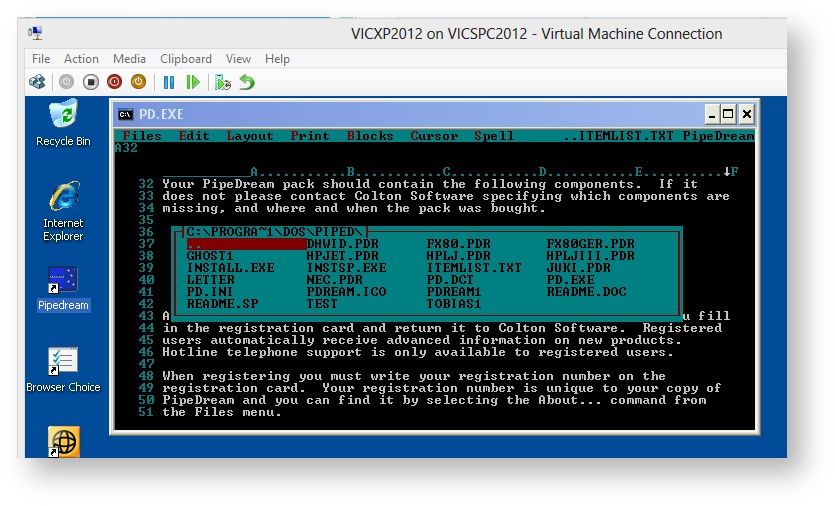
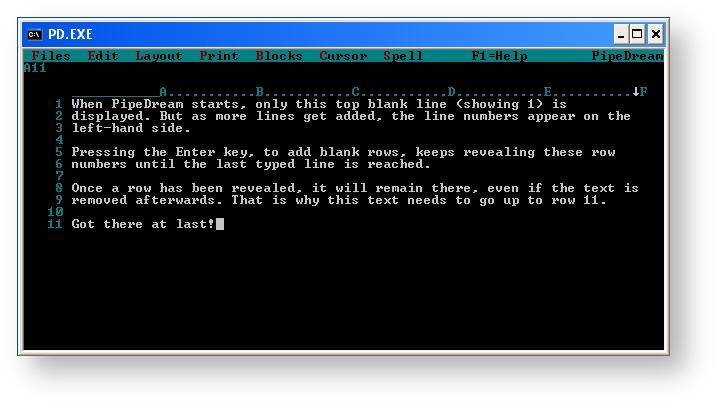
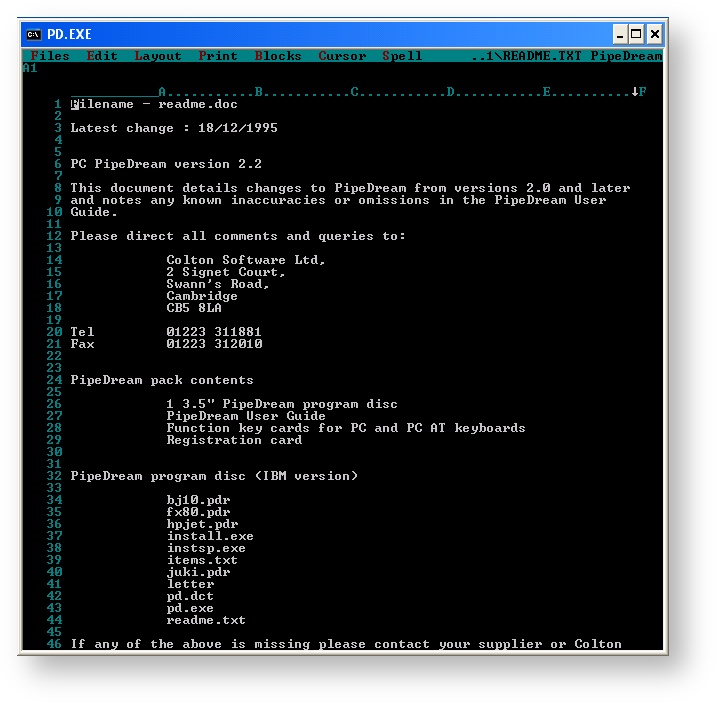
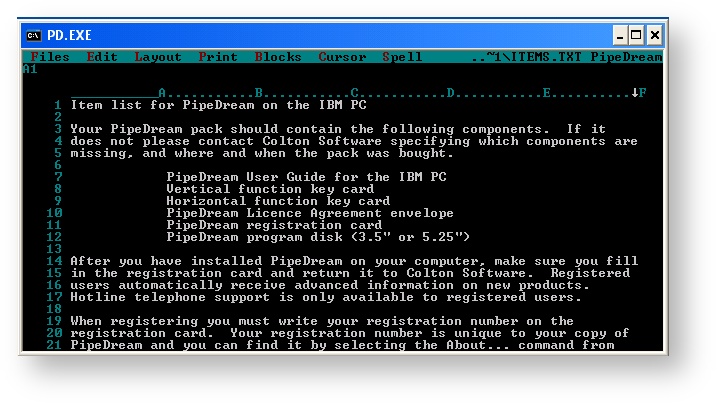
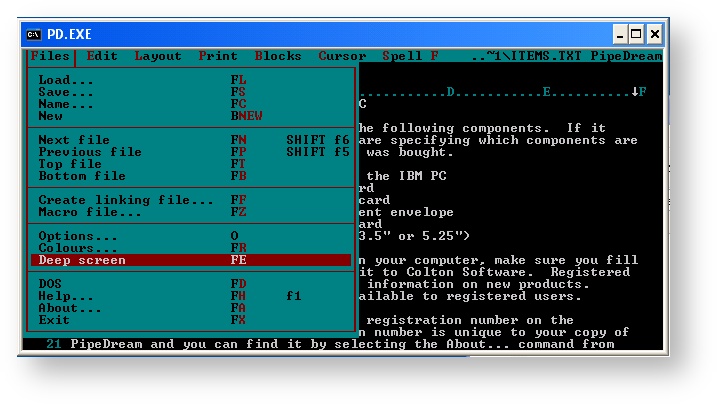





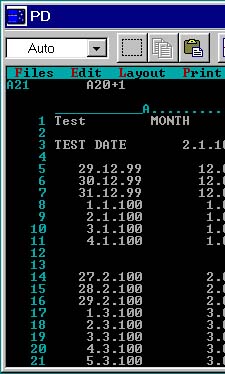
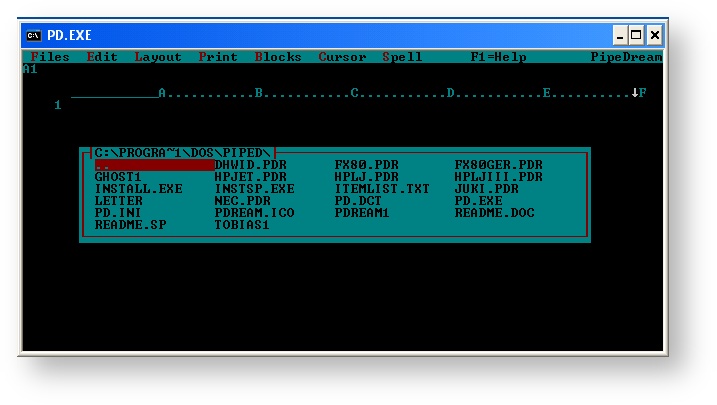
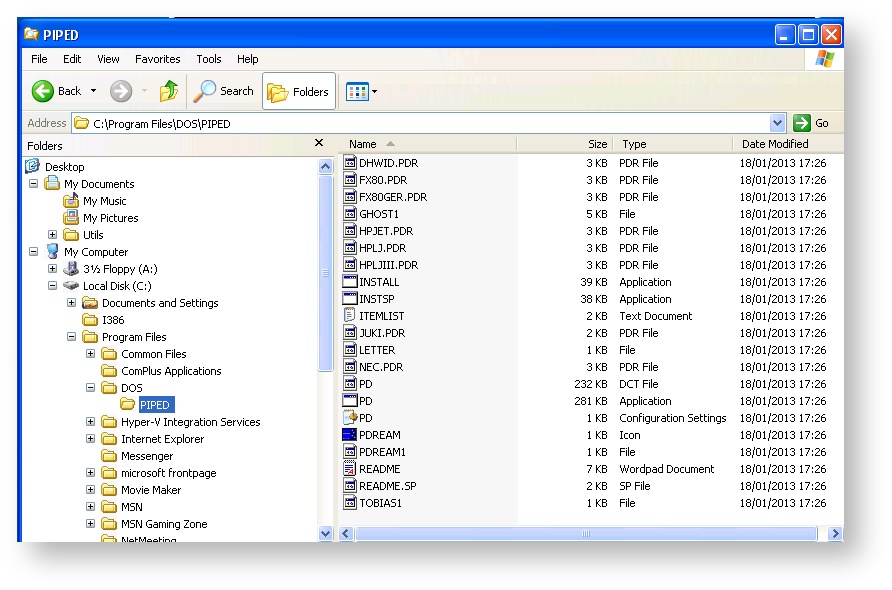
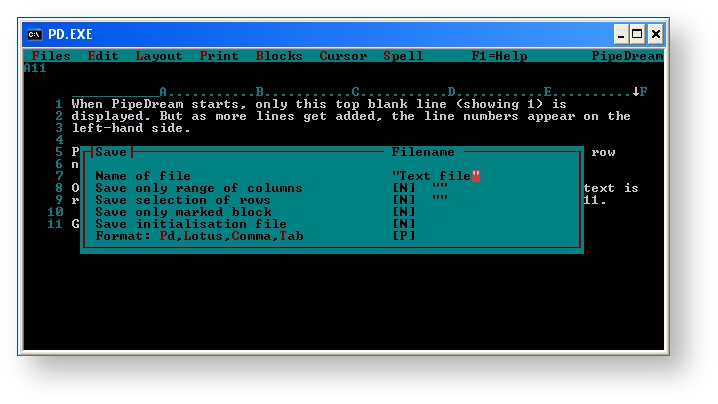

I got dosbox up and running, managed to get pipedream going easily enough. Couldn't get pipedream to recognize the USB-serial port (com3 on my system), so no direct comms between PC and Z88 using Pipedream, but eazyLink works well, and now i can work on files in Pipedream across platforms, so that is useful and fun. Thanks for the continued enthusiasm and help.